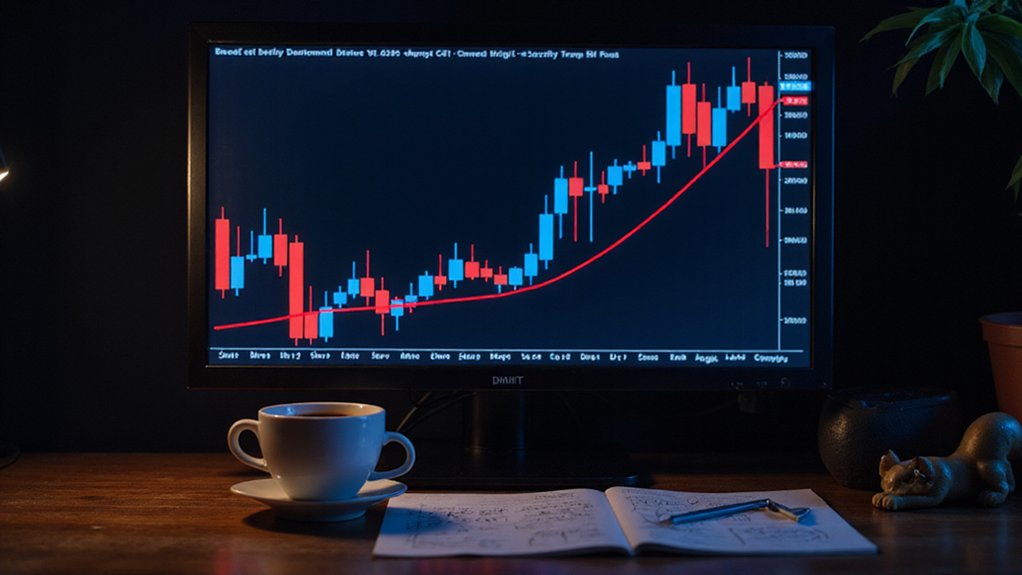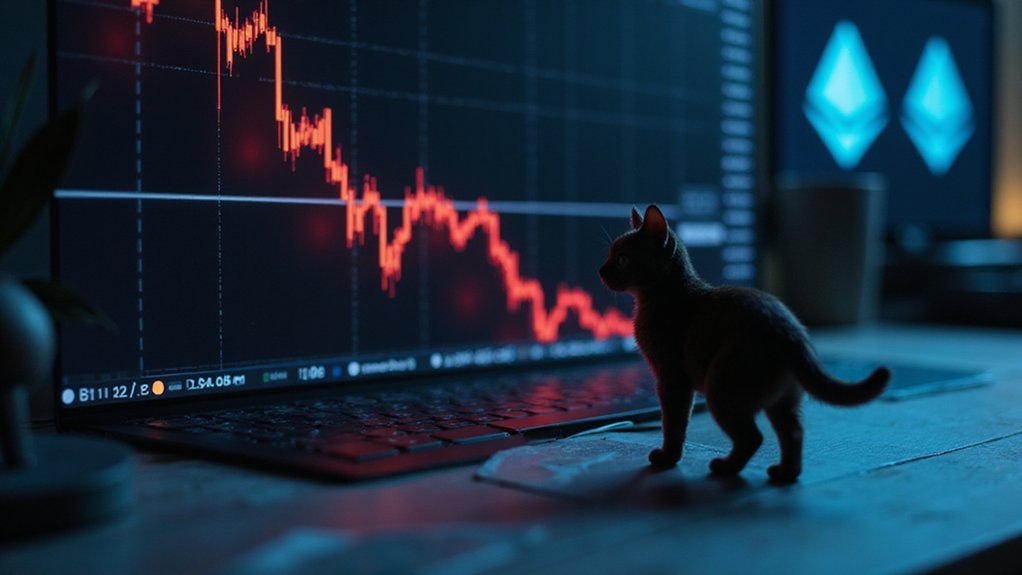A “dead cat bounce” in crypto markets describes a brief, deceptive price recovery amid an established downtrend. This morbidly-named phenomenon—suggesting even deceased felines rebound when dropped from sufficient heights—typically emerges after precipitous declines when speculative buying temporarily interrupts downward momentum. Traders, desperate for positive signals amid value erosion, often misinterpret these transient upswings as genuine reversals. Distinguishing between fleeting bounces and authentic recoveries requires contextual understanding beyond isolated technical patterns—a skill separating the fortunate from the fleeced.

The peculiar phenomenon known as a “dead cat bounce” represents one of the crypto market‘s most deceptive patterns—a fleeting upward surge that offers false hope amid a prolonged downward spiral.
Derived from the macabre yet oddly illustrative notion that even a deceased feline will rebound if dropped from sufficient height, this term encapsulates momentary price recoveries that materialize within established bear markets, tempting unwary investors with the mirage of reversal.
Even deceased felines achieve momentary flight when gravity momentarily relinquishes its claim—just as dying markets flash deceptive signs of life.
These ephemeral rallies, bereft of fundamental market strength, typically emerge after precipitous declines when speculative buying or algorithmic trading temporarily interrupts the downward momentum.
The psychological component cannot be overstated; traders, having witnessed substantial value erosion, desperately grasp at any positive signal—however tenuous—to justify optimism.
This collective behavior inadvertently intensifies the bounce itself, creating a self-fulfilling prophecy that inevitably collapses under scrutiny.
Technical analysts recognize these patterns retrospectively through their signature profile: sharp decline, brief recovery that fails to breach previous resistance levels, followed by continued deterioration.
The crypto ecosystem, with its inherent volatility and sentiment-driven price action, provides particularly fertile ground for such phenomena.
Indeed, the liquidity characteristics of digital assets can amplify these dead cat bounces to seemingly impressive proportions, further confounding market participants.
The practical implications for traders prove sobering.
Misinterpreting these bounces as genuine market reversals constitutes a classic trap, exposing portfolios to additional downside risk as the prevailing bearish trend reasserts itself.
Prudent market navigation requires distinguishing between transient bounces and authentic recoveries—a distinction that demands contextual understanding beyond isolated technical signals.
Since its first documented appearance in financial literature circa 1985, the dead cat bounce has transcended asset classes to become crypto vernacular, serving as stark reminder that markets rarely move linearly.
These patterns underscore crypto’s cyclical nature, where sentiment oscillates dramatically, creating traps for the uninitiated and opportunities for the discerning who recognize that in bearish conditions, not every rebound signals resurrection.
Similar to traditional markets where investor confidence plays a crucial role in determining price movements, crypto dead cat bounces often reflect temporary emotional reactions rather than fundamental strength.
These rallies typically last from a few days to months before the downtrend resumes, giving investors a false sense of market recovery.
Recent market spikes have prompted analysts to question whether these surges represent legitimate turnarounds or merely temporary recoveries within the broader sell-off context.
Frequently Asked Questions
What Tools Can Detect a Dead Cat Bounce in Crypto Markets?
Several tools can detect dead cat bounces in crypto markets: technical analysis platforms employing moving averages and RSI indicators; AI-driven pattern recognition software like Tickeron; advanced charting tools that visualize support/resistance levels; machine learning algorithms processing real-time data; and automated trading systems with backtesting capabilities.
Traders also rely on Bollinger Bands to analyze volatility and trend lines to identify potential reversals.
These instruments, while sophisticated, remain probabilistic rather than deterministic in the notoriously capricious crypto ecosystem.
How Does Trading Volume Affect Dead Cat Bounce Patterns?
Trading volume serves as the pulse of dead cat bounce patterns, often revealing their ephemeral nature.
Low volume during price recoveries typically signals weak market conviction—a hallmark of these deceptive rallies.
True reversals, by contrast, demonstrate robust and increasing volume profiles.
The divergence between price action and volume (rising prices on declining volume) frequently portends imminent collapse, while volume contraction following the initial bounce usually precedes renewed selling pressure.
Seasoned traders know: in these patterns, volume speaks louder than price.
Can Algorithmic Trading Profit From Dead Cat Bounces?
Algorithmic trading can indeed profit from dead cat bounces by deploying precise technical indicators that identify temporary price recoveries within broader downtrends.
Success hinges on sophisticated pattern recognition algorithms capable of distinguishing genuine trend reversals from fleeting upticks.
Well-calibrated systems can execute rapid entries and exits, though the challenge remains formidable—separating signal from noise requires algorithms that incorporate volume analysis, market sentiment metrics, and adjustable stop-loss parameters for effective risk management.
Do Stablecoins Experience Dead Cat Bounces?
Stablecoins do experience dead cat bounces, albeit with distinctive characteristics compared to volatile cryptocurrencies.
During de-pegging events, these supposedly “stable” assets can exhibit temporary price recoveries after significant drops, mimicking the classic dead cat bounce pattern.
This phenomenon manifests primarily through brief peg recoveries followed by continued deviation, with market capitalization metrics revealing sharp declines and partial rebounds.
Trading volume during these episodes typically remains low—nature’s way of signaling that stability, once lost, rarely returns without intervention.
What’s the Average Duration of a Crypto Dead Cat Bounce?
Crypto dead cat bounces defy convenient statistical packaging, ranging from fleeting day-long spikes to protracted multi-month recoveries.
Market observers seeking an “average” duration chase a phantom metric—like measuring the average length of market delusions.
These temporary rallies typically persist for 1-4 weeks, though this window expands or contracts based on prevailing sentiment, short-covering momentum, and the market’s collective ability to sustain unfounded optimism before fundamental gravity reasserts itself.









